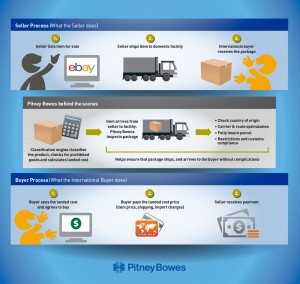While omnichannel retailing is in the spotlight these days, lurking in the shadows is another big challenge and opportunity many retailers (and manufacturers looking to sell direct to consumers) have been struggling with for years: cross-border e-commerce.
It may sound simple, but enabling a consumer in one country to buy from an online retailer in another country is incredibly complex. In addition to language and currency considerations, there are many other factors that come into play, including cost factors (duties, taxes, brokerage fees), customs compliance requirements (product classification, restricted party screening, import/export documentation), and complying with the address formats of destination countries to prevent delays and other issues with last-mile delivery.
Not surprising, with the exception of Amazon, eBay, and a few other e-commerce giants, most online retailers have stayed away from selling to consumers in other countries, or they have limited their sales to a very finite number of countries (cross-border e-commerce reached $300 billion in 2012, while global online trade will top $1.4 trillion by 2015). Simply put, many online retailers, especially small and midsize ones, lack the internal expertise and technology to make cross-border e-commerce work.
That is the backstory behind UPS acquiring i-parcel this week. Here are some details about the acquisition from the press release:
i-parcel Global e-Commerce merchants connect to over 100 million global shoppers with an integrated platform that provides a localized look and feel on the respective merchant’s website. The i-parcel platform supports merchant’s websites with a local language welcome mat, fraud protection, fully-landed total prices (including customs duties and taxes) in local currency and numerous value enhancing features. These features enable consumers in over 100 countries to shop online in the U.S. and U.K. as if they were shopping in their own country. i-parcel also provides low-cost deferred international transportation facilitating higher shopper conversion for merchants on lower-value goods. The combined software and transportation solutions allow merchants in the U.S. and U.K., two of the largest e-commerce markets, to reach a broader international consumer base without expanding their footprint.
This is another example of the convergence I’ve been talking about, where supply chain and logistics solution providers are bringing together technology with managed services (along with consulting) to enable retailers and manufacturers to achieve their desired outcomes — in this case, launching and scaling their cross-border e-commerce capabilities quickly and cost effectively.
Pitney Bowes offers a similar solution for eBay sellers and buyers called the Global Shipping Program (read about it here), which includes product classification; a landed cost engine that provides international buyers “with the total cost, including duties, taxes, and shipping charges, during check-out, so there are no surprise fees upon delivery”; package inspection and preparation services, including capturing country of origin and other information required for customs clearance; and working with “a network of best-in-class customs brokers, delivery agents, carriers, and a number of partners to get the package to the buyer cost-effectively and with a high degree of reliability.”

Although these solutions are certainly facilitating cross-border e-commerce, they are not a silver bullet, and some big challenges still exist, including educating consumers about the cross-border e-commerce process and how it differs from the domestic one. From what I’ve read online, many consumers are frustrated and confused, especially when shipments are excessively delayed due to missing information.
On Amazon.com, for example, there are several discussion forums dedicated to i-parcel, including one called “i-parcel Questions and Answers” (1,000 posts, as of today) and another called “i-parcel the worst shipping carrier” (953 posts). If you read through the posts, you’ll find many frustrated and confused Amazon customers like these:


And here are a couple Twitter posts:
Anyone use i-parcel before for shipping? 6 days already and still no updates! *sigh* pic.twitter.com/bcSdwRlaxa
— Wong Yong Jie (@yjwong) February 16, 2014
@AmazonHelp Is “i-parcel.com” a known phisher? They seem to have details about my package and are trying to get some personal info — Elias Tandel (@etandel) August 14, 2014
Elias Tandel then posted this image of the email he received from i-parcel, which highlights the information i-parcel was looking for in order to process the shipment:

And if you’re an eBay buyer using the Global Shipping Program, good luck understanding the Buyer Terms & Conditions and “Your Role as Foreign Principal Party in Interest.”
The bottom line: many consumers are not loving the cross-border e-commerce experience, and most of the issues are not with the buying part of the process, but with customs clearance and final delivery. In short, when it comes to cross-border e-commerce, the biggest challenge online retailers and its logistics service providers face today is answering the two most common questions consumers ask after placing an order: Where is my shipment? When will I receive it?
Answering those questions is no longer an issue with domestic e-commerce, and the trend is to provide consumers with even more visibility and more time-definite answers, including same-day delivery. When it comes to cross-border shipments, however, online retailers and logistics service providers are a long way from providing consumers with specific and reliable delivery dates and times at the time of purchase (e.g., “Your order from the U.S. will arrive at your house in Tokyo on October 15th between 12:00 and 15:00”). Getting there is the next big challenge for UPS, Pitney Bowes, and the rest of the industry. It will happen, but in the meantime, they’ll have to do a better job of educating consumers about the complexities involved in cross-border shipments, and do a better job of aligning consumer expectations with that messy reality.










